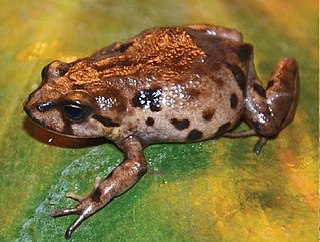
Phrynopus is a genus of frogs of the family Strabomantidae. Their common name is Andes frogs. They are endemic to Peru and inhabit the upper humid montane forest and supra-treeline grassland in the Cordillera Oriental, with one record from the Peruvian Cordillera Occidental.
Phrynopus barthlenae is a species of frog in the family Strabomantidae. It is endemic to Peru. Its natural habitats are subtropical or tropical moist montane forest, subtropical or tropical high-altitude grassland, arable land, pastureland, and rural gardens.
Phrynopus bracki is a species of frog in the family Strabomantidae. It is endemic to Peru and only known from its type locality in the Cordillera Yanachaga, Pasco Region. The specific name bracki honors Antonio Brack, agronomist and ecologist who was instrumental for the establishment of the Yanachaga–Chemillén National Park. Common name Brack's Andes frog, has been coined for it.
Phrynopus bufoides is a species of frog in the family Strabomantidae. It is endemic to Peru. Its natural habitat is subtropical or tropical high-altitude shrubland.
Ctenophryne carpish is a rare and little-known species of microhylid frogs endemic to Peru. It is known from its type locality on the Cordillera de Carpish, Huánuco, and from near Juanjuí in the San Martín Region. It lacks eardrums, and at a cursory glance it resembles leptodactylid frogs of the genus Phrynopus, in which it was initially placed.
Phrynopus dagmarae is a species of frog in the family Strabomantidae. It is endemic to the Andes of Peru and only known from the Pachitea and Ambo Provinces in the Huánuco Region, from near the type locality. The specific name dagmarae honors Dagmar Schramm from Germany.
Phrynopus heimorum is a species of frog in the family Strabomantidae. It is endemic to Peru. Its natural habitats are subtropical or tropical moist montane forest and subtropical or tropical high-altitude shrubland. It is threatened by habitat loss.
Phrynopus horstpauli is a species of frog in the family Strabomantidae. It is endemic to Peru. Its natural habitats are subtropical or tropical moist montane forest, subtropical or tropical high-altitude shrubland, pastureland, and rural gardens. It is threatened by habitat loss.

Phrynopus juninensis is a species of frog in the family Strabomantidae. It is endemic to Peru and only known from Cascas near Huasihuasi, Department of Junín. Records from Department of Pasco probably belong to another species. Common name Junin Andes frog has been proposed for this species.

Phrynopus kauneorum is a species of frogs in the family Strabomantidae. It is endemic to the Andes of Peru and known from near its type locality in the Pachitea Province, as well as from the Cordillera de Carpish, both in the Huánuco Region. The specific name kauneorum honors Andreas, Meeta, and Rebekka Kaune from Germany.
Phrynopus montium is a species of frog in the family Strabomantidae. It is endemic to Peru and only known from two localities near Cascas in the Junín Region: "Cascas near Huasahuasi", the imprecisely known type locality where the types were collected in 1936, and south of Hacienda Cascas, where it was found in 2014. Records from the PascoPasco and Huánuco Regions refer to Phrynopus kotosh and Phrynopus oblivius, respectively. Common name Cascas Andes frog has been coined for this species.
Phrynopus paucari is a species of frog in the family Strabomantidae. It is endemic to Peru. Its natural habitat is subtropical or tropical high-altitude grassland.
Phrynopus pesantesi is a species of frog in the family Strabomantidae. It is endemic to Peru. Its natural habitat is subtropical or tropical high-altitude grassland.
Phrynopus thompsoni is a species of frog in the family Strabomantidae. It is endemic to Peru.
Phrynopus auriculatus is a species of frog in the family Strabomantidae. It is endemic to Peru and only known from its type locality near Oxapampa, Pasco, at 2,600 m (8,500 ft) asl. It inhabits humid montane forest.
Phrynopus tribulosus is a species of frog in the family Strabomantidae. It is endemic to Peru and only known from its type locality near Oxapampa at 2,600 m (8,500 ft) asl, and from Santa Bárbara, in the Huancabamba District, Oxapampa, Pasco Region. It inhabits humid montane forests where individuals could be found deep within a mossy bank by day.
Phrynopus kotosh is a species of frog in the family Strabomantidae. It is endemic to Peru and only known from its type locality near Huancapallac, Huánuco Region, at 2,950 m (9,680 ft) asl in the Cordillera Central. The specific name refers to the pre-Columbian culture Kotosh; ruins from this culture are known from the area of the type locality.
Phrynopus oblivius is a species of frog in the family Strabomantidae. It is endemic to central Peru and only known from near its type locality near Maraynioc, in the Tarma Province, Junín Region, at about 3,210–3,220 m (10,530–10,560 ft) asl. It is known from a collection in 2005; there has been no later surveys for the species.
Phrynopus miroslawae is a species of frog in the family Strabomantidae. It is endemic to Peru and only known from its type locality, Santa Bárbara, in the Huancabamba District, Oxapampa, Pasco Region. The species is only known from the holotype collected in 2007. The specific name miroslawae honors Miroslawa Jagielko from Poland, recognizing her "friendship and support of taxonomic research and nature conservation in Peru".
Phrynopus tautzorum is a species of frog in the family Strabomantidae. It is endemic to Peru and only known from its type locality near Maraypata, in the Ambo Province, Huánuco Region, at 3,770 m (12,370 ft) asl. It lives in the puna grassland ecoregion. Individuals have found under stones on moist underground. Livestock farming occurred at the type locality, but its impact on this species is unknown.



